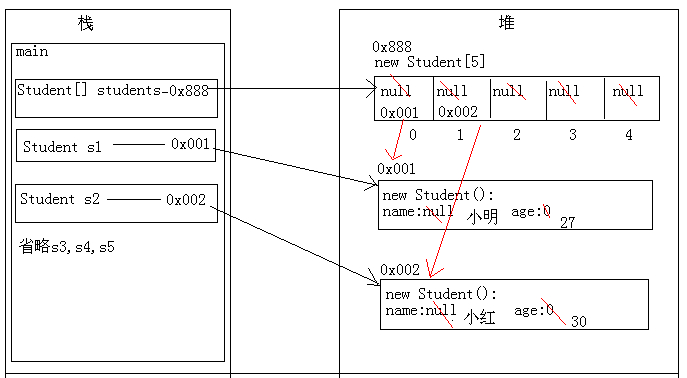JavaSe总结-15- 集合框架
来源:互联网 发布:数据库维护计划 编辑:程序博客网 时间:2024/06/05 19:47
15.01 对象数组的概述和使用
15.02 对象数组的内存图解
15.03 集合的由来及与数组的区别
15.04 集合的继承体系图解
15.05 Collection集合的功能概述
15.06 Collection集合的基本功能测试
15.07 Collection集合的高级功能测试
15.08 集合的遍历之集合转数组遍历
15.09 Collection存储自定义对象并遍历案例(使用数组)
15.10 集合的遍历之迭代器遍历
15.11 Collection存储自定义对象并遍历案例(使用迭代器)
15.12 迭代器使用的问题探讨
15.13 集合的使用步骤图解
15.14 迭代器的原理及源码解析
15.15 Collection存储字符串并遍历
15.16 Collection存储学生对象并遍历
15.17 List存储字符串并遍历
15.18 List集合的特点
15.19 List存储学生对象并遍历
15.20 List集合的特有功能概述和测试
15.21 List集合的特有遍历功能
15.22 List存储自定义对象并遍历(使用List特有功能遍历)
15.23 ListIterator的特有功能
15.24 并发修改异常的产生原因及解决方案
15.25 数据结构之栈和队列
15.26 数据结构之数组和链表
15.27 List的三个子类的特点
15.01 对象数组的概述和使用
1 public class Student 2 { 3 // 成员变量 4 private String name; 5 private int age; 6 7 // 构造方法 8 public Student() 9 {10 super();11 }12 13 public Student(String name, int age) 14 {15 super();16 this.name = name;17 this.age = age;18 }19 20 // 成员方法21 // getXxx()/setXxx()22 public String getName() 23 {24 return name;25 }26 27 public void setName(String name) 28 {29 this.name = name;30 }31 32 public int getAge() 33 {34 return age;35 }36 37 public void setAge(int age) 38 {39 this.age = age;40 }41 42 @Override43 public String toString() 44 {45 return "Student [name=" + name + ", age=" + age + "]";46 }47 }
1 /** 2 把5个学生的信息存储到数组中,并遍历数组,获取得到每一个学生信息。 3 * 学生:Student 4 * 成员变量:name,age 5 * 构造方法:无参,带参 6 * 成员方法:getXxx()/setXxx() 7 * 分析: 8 * A:创建学生类。 9 * B:创建学生数组(对象数组)。10 * C:创建5个学生对象,并赋值。11 * D:把C步骤的元素,放到数组中。12 * E:遍历学生数组。13 * */14 15 public class Practice 16 {17 public static void main(String[] args)18 {19 // 创建学生数组(对象数组)。20 Student[] students = new Student[5];21 // for (int x = 0; x < students.length; x++) 22 // {23 // System.out.println(students[x]);24 // }25 // System.out.println("---------------------");26 27 // 创建5个学生对象,并赋值。28 Student s1 = new Student("小明", 27);29 Student s2 = new Student("小红", 30);30 Student s3 = new Student("小强", 30);31 Student s4 = new Student("旺财", 12);32 Student s5 = new Student("张三", 35);33 34 // 将对象放到数组中。35 students[0] = s1;36 students[1] = s2;37 students[2] = s3;38 students[3] = s4;39 students[4] = s5;40 41 // 遍历42 for (int x = 0; x < students.length; x++) 43 {44 //System.out.println(students[x]);45 Student s = students[x];46 System.out.println(s.getName()+"---"+s.getAge());47 }48 }49 }
15.02 对象数组的内存图解

15.03 集合的由来及与数组的区别
集合类的由来:面向对象语言对事物的体现都是以对象的形式,所以为了方便对多个对象的操作,Java就提供了集合类。
数组和集合类同的区别:
数组可以存储同一种类型的基本数据也可以存储同一种类型的对象,但长度是固定的
集合只可以存储不同类型的对象,长度是可变的
集合类的特点:集合只用于存储对象,集合长度是可变的,集合可以存储不同类型的对象。
15.04 集合的继承体系图解
集合容器因为内部的数据结构不同,有多种具体容器,根据共性内容不断的向上抽取,就形成了集合框架。
框架的顶层Collection接口

15.05 Collection集合的功能概述
Collection 层次结构中的根接口。Collection 表示一组对象,这些对象也称为 collection 的元素。一些 collection 允许有重复的元素,而另一些则不允许。一些 collection 是有序的,而另一些则是无序的。JDK 不提供此接口的任何直接实现:它提供更具体的子接口(如 Set 和 List)实现。此接口通常用来传递 collection,并在需要最大普遍性的地方操作这些 collection。
15.06 Collection集合的基本功能测试
成员方法:
1. boolean add(E e):确保此 collection 包含指定的元素(可选操作)。
2. boolean remove(Object o):从此 collection 中移除指定元素的单个实例,如果存在的话(可选操作)。
3. void clear():移除此 collection 中的所有元素(可选操作)。
4. boolean contains(Object o):如果此 collection 包含指定的元素,则返回 true。
5. boolean isEmpty():如果此 collection 不包含元素,则返回 true。
6. int size():返回此 collection 中的元素数。
例:
1 // 创建集合对象 2 // Collection c = new Collection(); //错误,因为接口不能实例化 3 Collection c = new ArrayList(); 4 c.add("hello"); 5 c.add("world"); 6 c.add("java"); 7 // c.clear();//移除所有元素 8 // System.out.println("remove:" + c.remove("hello"));//移除一个元素 9 // System.out.println("remove:" + c.remove("javaee"));10 // 判断集合中是否包含指定的元素11 System.out.println("contains:"+c.contains("hello"));//contains:true12 System.out.println("contains:"+c.contains("android"));//contains:false13 //判断集合是否为空14 System.out.println("isEmpty:"+c.isEmpty());//isEmpty:false15 //元素的个数16 System.out.println("size:"+c.size());//size:317 System.out.println("c:" + c);//c:[hello, world, java]
15.07 Collection集合的高级功能测试
成员方法:
1. boolean addAll(Collection<? extends E> c):
将指定 collection 中的所有元素都添加到此 collection 中(可选操作)。
2. boolean removeAll(Collection<?> c):
移除此 collection 中那些也包含在指定 collection 中的所有元素(可选操作)。
3. boolean containsAll(Collection<?> c):
如果此 collection 包含指定 collection 中的所有元素,则返回 true。
4. boolean retainAll(Collection<?> c):
仅保留此 collection 中那些也包含在指定 collection 的元素(可选操作)。换句话说,移除此 collection 中未包含在指定 collection 中的所有元素。
例:
c1.addAll(c2);//将c2集合中的所有元素添加到c1集合中,c1变c2不变c1.removeAll(c2);//将c1集合中与c2集合相同的所有元素删除,只要有一个相同的就返回truec1.containsAll(c2);//判断c1集合中的元素是否包含c2中的全部元素,全部包含则返回truec1.retainAll(c2);//将c1集合中与c2集合相同的元素保留,删除其他元素,返回值表示c1集合是否发生变化,发生变化返回true,没有变化返回false15.08 集合的遍历之集合转数组遍历
Object[] toArray():返回包含此 collection 中所有元素的数组。
例:
1 public class Practice 2 { 3 public static void main(String[] args) 4 { 5 // 创建集合 6 Collection c = new ArrayList(); 7 c.add("hello"); 8 c.add("world"); 9 c.add("java");10 11 Object[] objs = c.toArray();12 for (int i = 0; i < objs.length; i++) 13 {14 //向下转为String类型15 String s = (String)objs[i];16 System.out.println(s+":"+s.length());17 }18 }19 }运行结果:
hello:5world:5java:4
15.09 Collection存储自定义对象并遍历案例(使用数组)
例:
1 public class Practice 2 { 3 public static void main(String[] args) 4 { 5 // 创建集合 6 Collection c = new ArrayList(); 7 //创建学生对象并添加到集合 8 c.add(new Student("小明",23)); 9 c.add(new Student("小红",32));10 c.add(new Student("小强",14));11 c.add(new Student("旺财",8));12 c.add(new Student("张三",16));13 14 Object[] objs = c.toArray();15 for (int i = 0; i < objs.length; i++) 16 {17 Student s = (Student)objs[i];18 System.out.println(s.getName()+":"+s.getAge());19 }20 }21 }运行结果:
小明:23小红:32小强:14旺财:8张三:1615.10 集合的遍历之迭代器遍历
Iterator<E> iterator():返回在此 collection 的元素上进行迭代的迭代器。
例:
1 // 创建集合 2 Collection c = new ArrayList(); 3 //创建元素并添加到集合 4 c.add("hello"); 5 c.add("world"); 6 c.add("java"); 7 //获取迭代器,实际返回的是子类对象,多态 8 Iterator it = c.iterator(); 9 while(it.hasNext())10 {11 System.out.println(it.next());12 }15.11 Collection存储自定义对象并遍历案例(使用迭代器)
1 public class Practice 2 { 3 public static void main(String[] args) 4 { 5 // 创建集合 6 Collection c = new ArrayList(); 7 //创建学生对象并添加到集合 8 c.add(new Student("小明",23)); 9 c.add(new Student("小红",32));10 c.add(new Student("小强",14));11 c.add(new Student("旺财",8));12 c.add(new Student("张三",16));13 14 Iterator it = c.iterator();15 while(it.hasNext())16 {17 Student s = (Student)it.next();18 System.out.println(s.getName()+":"+s.getAge());19 }20 }21 }15.12 迭代器使用的问题探讨
1.使用迭代器获取元素的两种方式:
方式1:
Iterator it = c.iterator();while(it.hasNext()){ Student s = (Student)it.next(); System.out.println(s.getName()+":"+s.getAge());}方式2:
for(Iterator it = c.iterator();it.hasNext();){ Student s = (Student)it.next(); System.out.println(s.getName()+":"+s.getAge());}使用方式2的好处:it在for循环结束后就变成垃圾,效率较高
2.不要多次使用it.next()方法
例:
Iterator it = c.iterator();while(it.hasNext()){ System.out.println(((Student)it.next()).getName()); System.out.println(((Student)it.next()).getAge());}上面的代码表示获取的是第1个学生的姓名,第2个学生的年龄,以此类推,如果集合中的元素是奇数个,则会报NoSuchElementException错误
15.13 集合的使用步骤图解

集合的使用步骤:
1. 创建集合对象
2. 创建元素对象
3. 将元素添加到集合
4. 遍历集合
4.1 通过集合对象获取迭代器对象
4.2 通过迭代器对象的hasNext()方法判断是否有元素
4.3 通过迭代器对象的Next()方法获取元素并移动到下一个位置
15.14 迭代器的原理及源码解析
原理:
假设迭代器定义的是一个类,那么就可以创建该类的对象,调用该类的方法来实现集合的遍历,但是Java中提供了很多的集合类,而这些集合类的数据结构是不同的,所以存储的方式和遍历的方式也应该是不同的,进而它们的遍历方式也应该是不一样的。最终就没有定义迭代器类
而无论使用哪种集合都应该具备获取元素的操作,并且最好再辅助与判断功能,也就是说判断功能和获取功能应该是一个集合遍历所具备的,而每种集合的方式又不太一样,所以将这两个功能给提取出来,并不提供具体实现,这种方式就是接口,而真正具体的实现类在具体的子类中以内部类的方式体现的
源码:
public interface Iterator { boolean hasNext(); Object next(); }public interface Iterable { Iterator iterator();}public interface Collection extends Iterable { Iterator iterator();}public interface List extends Collection { Iterator iterator();}public class ArrayList implements List { public Iterator iterator() { return new Itr(); } //内部类 private class Itr implements Iterator { public boolean hasNext() {} public Object next(){} }}Collection c = new ArrayList();c.add("hello");c.add("world");c.add("java");Iterator it = c.iterator(); //new Itr();while(it.hasNext()) { String s = (String)it.next(); System.out.println(s);}
15.15 Collection存储字符串并遍历
1 import java.util.ArrayList; 2 import java.util.Collection; 3 import java.util.Iterator; 4 5 public class Practice 6 { 7 8 public static void main(String[] args) 9 {10 11 // 创建集合12 Collection c = new ArrayList();13 14 //添加字符串15 c.add("hello");16 c.add("你好");17 c.add("world");18 c.add("java");19 c.add("旺财");20 //通过集合对象获取迭代器对象21 22 Iterator it = c.iterator();23 while(it.hasNext())24 25 {26 String s = (String)it.next();27 28 System.out.println(s);29 }30 31 }32 33 }15.16 Collection存储学生对象并遍历
1 import java.util.ArrayList; 2 import java.util.Collection; 3 import java.util.Iterator; 4 5 public class Practice 6 { 7 public static void main(String[] args) 8 { 9 // 创建集合10 Collection c = new ArrayList();11 //创建学生对象并添加到集合12 c.add(new Student("小明",23));13 c.add(new Student("小红",32));14 c.add(new Student("小强",14));15 c.add(new Student("旺财",8));16 c.add(new Student("张三",16));17 18 Iterator it = c.iterator();19 while(it.hasNext())20 {21 Student s = (Student)it.next();22 System.out.println(s.getName()+":"+s.getAge());23 }24 }25 }15.17 List存储字符串并遍历
1 public class Practice 2 { 3 public static void main(String[] args) 4 { 5 // 创建集合 6 List list = new ArrayList(); 7 list.add("hello"); 8 list.add("world"); 9 list.add("java");10 11 Iterator it = list.iterator();12 while(it.hasNext())13 {14 String s = (String)it.next();15 System.out.println(s);16 }17 }18 }15.18 List集合的特点
List接口概述:有序的(存取顺序一致)collection(也称为序列)。此接口的用户可以对列表中每个元素的插入位置进行精确地控制。用户可以根据元素的整数索引(在列表中的位置)访问元素,并搜索列表中的元素。
特点:与 set 不同,列表通常允许重复的元素。
15.19 List存储学生对象并遍历
1 public class Practice 2 { 3 public static void main(String[] args) 4 { 5 // 创建集合 6 List list = new ArrayList(); 7 //创建学生对象并添加到集合 8 list.add(new Student("小明",23)); 9 list.add(new Student("小红",32));10 list.add(new Student("小强",14));11 list.add(new Student("旺财",8));12 list.add(new Student("张三",16));13 14 Iterator it = list.iterator();15 while(it.hasNext())16 {17 Student s = (Student)it.next();18 System.out.println(s.getName()+":"+s.getAge());19 }20 }21 }15.20 List集合的特有功能概述和测试
1. void add(int index,E element):
在列表的指定位置插入指定元素(可选操作)。
2. E remove(int index):
移除列表中指定位置的元素(可选操作)。
3. E get(int index):
返回列表中指定位置的元素。
4. E set(int index, E element):
用指定元素替换列表中指定位置的元素(可选操作)。
例:
list.add(2,"javaee");//在2的位置插入javaee,改变集合长度
list.get(2)//返回集合中2位置上的元素,不改变集合长度
list.remove(1)//删除集合中1位置上的元素,返回被删除的元素,改变集合长度
list.set(2, "javaee")//将集合中2位置上的元素替换为javaee,返回被替换的元素,不改变集合长度
15.21 List集合的特有遍历功能
1 for (int i = 0; i < list.size(); i++) 2 3 {4 5 String s = (String)list.get(i);6 7 System.out.println(s);8 9 }15.22 List存储自定义对象并遍历(使用List特有功能遍历)
1 public class Practice 2 { 3 public static void main(String[] args) 4 { 5 // 创建集合 6 List list = new ArrayList(); 7 //创建学生对象并添加到集合 8 list.add(new Student("小明",23)); 9 list.add(new Student("小红",32));10 list.add(new Student("小强",14));11 list.add(new Student("旺财",8));12 list.add(new Student("张三",16));13 14 for (int i = 0; i < list.size(); i++) 15 {16 Student s =(Student)list.get(i);17 System.out.println(s.getName()+":"+s.getAge());18 }19 }20 }15.23 ListIterator的特有功能
ListIterator<E> listIterator():
返回此列表元素的列表迭代器(按适当顺序)。
注意:ListIterator可以实现逆向遍历,但是必须先正向遍历,才能逆向遍历
例:
1 public class Practice 2 { 3 public static void main(String[] args) 4 { 5 // 创建集合 6 List list = new ArrayList(); 7 8 list.add("hello"); 9 list.add("world");10 list.add("java");11 //列表迭代器12 ListIterator lit = list.listIterator();13 //正向遍历14 while(lit.hasNext())15 {16 String s = (String)lit.next();17 System.out.println(s);18 }19 System.out.println("-----");20 //逆向遍历21 while(lit.hasPrevious())22 {23 //获取上一个元素24 String s = (String)lit.previous();25 System.out.println(s);26 }27 28 }29 }运行结果:
hello
world
java
-----
java
world
hello
15.24 并发修改异常的产生原因及解决方案
例:
1 public class Practice 2 { 3 public static void main(String[] args) 4 { 5 // 创建集合 6 List list = new ArrayList(); 7 8 list.add("hello"); 9 list.add("world");10 list.add("java");11 Iterator it = list.iterator();12 while(it.hasNext())13 {14 String s = (String)it.next();15 if(s.equals("world"))16 list.add("javaee"); 17 }18 System.out.println(list);19 }20 }上面的代码会运行错误,发生ConcurrentModificationException异常
错误产生原因:迭代器是依赖于集合存在的,在迭代的过程中使用集合的方法添加元素迭代器是不知道的,所以报错,并发修改异常
解决方案:1.用迭代器迭代元素时使用迭代器修改元素(ListIterator列表迭代器),添加的元素在迭代的元素后面
2.用集合遍历元素,用集合修改元素(for循环),添加的元素在最后
15.25 数据结构之栈和队列
数据结构:数据的组织方式

15.26 数据结构之数组和链表
数组:存储同一种类型的多个元素的容器

链表:由一个链子把多个节点(数据和节点)连起来组成的数据

15.27 List的三个子类的特点
ArrayList:底层数据结构是数组,查询快,增删慢,是不同步的,线程不安全,效率高
Vector:底层数据结构是数组,查询快,增删慢,是同步的,线程安全,效率低
LinkedList:底层数据结构是链表,查询慢,增删快,是不同步的,线程不安全,效率高
- JavaSe总结-15- 集合框架
- JavaSE集合框架总结
- JavaSE总结 -集合框架collection
- JavaSE总结-集合框架-List
- JavaSe总结-16- 集合框架(2)
- JavaSe总结-17- 集合框架(3)
- JavaSe总结-18- 集合框架(4)
- JAVASE之集合框架
- JAVASE----09----集合框架
- javaSE--集合框架
- 黑马程序员——JavaSE之集合框架总结二
- JavaSe集合总结
- JAVASE总结--集合
- [JavaSe学习笔记-集合框架]
- JavaSE学习笔记--集合框架
- JAVASE之集合框架-----List
- JAVASE之集合框架-----Set
- JAVASE之集合框架-----Map
- 大数据入门:各种大数据技术的介绍
- JavaSe总结-14- API常用对象(4)
- K线别人的家的总结
- 关于前端的js的一些基本内容(1)
- 京东一元抢宝系统的数据库架构优化
- JavaSe总结-15- 集合框架
- 浮动布局所带来的影响以及如何清除浮动
- POJ 3997 Stock Chase 已被翻译
- Linux配置网络
- android中如何在活动在回收时保存临时数据
- cfg80211 subsystem中的cfg80211_ops
- 告诉你什么是javascript的回调函数
- Docker的安装
- SpringMVC处理静态文件源码分析



